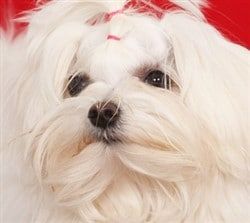Maltese Liver Shunts
What This Is
The Maltese breed, along with the Yorkshire Terrier and Wolfhound, has a 20 time greater risk of congenial liver shunts than all other breeds.
A liver shunt, also called a portosystemic shunt (PSS), is a genetic defect in which there is a problem with the vein that carries blood in and out of the liver. Normally, blood that is brought through the liver is filtered out and then sent back into the body. A shunt, which is a diversion of this flow, leads to a toxic buildup in the body.
There are two types of liver shunts seen in Maltese and other breeds:
Intrahepatic: Blood is diverted into a vessel within the liver.
Extrahepatic: Blood is diverted outside of the liver.
A shunt may be partial (some of the blood flow is blocked) or full (all of the blood flow is blocked).
In either case, this is usually a very serious condition that needs to be treated as soon as possible, as toxins quickly build up a dog's body.
What Causes This
This is a congenital defect, meaning that a Maltese puppy is born with this.
In fact, this is present long before a pup is whelped. The reason that a puppy with a liver shunt survives while still in the womb is because the dam's liver is doing the work of filtering the fetus's blood via the connection of the placenta. After the pup is whelped and his own liver takes over, this is when symptoms can start appearing.
Signs and Symptoms
Age of onset:
If there is a full shunt, signs may appear early, in just weeks or months. If there is a partial shunt, signs usually appear by the one year mark.
In 75% of cases, liver shunts will start to manifest clinical signs by the age of one year old. For 25% of dogs that suffer from this, signs will appear after the one year mark, and generally no later than two years old.
Symptoms may be constant or come and go, and generally include one or more of the following:
Abnormal vocalization
Appetite changes (decreased or increased appetite and/or pica which is a craving for non-food items)
Ataxia (lack of coordination)
Circling
Constipation
Diarrhea
Disorientation
Drooling
Head pressing (the dog presses his head against surfaces such as the floor or wall)
Increased thirst
Increased urination
Pacing
Poor growth rates
Tremors
Vision issues (apparent limited vision or blindness)
Vomiting
Walking in circles
Weakness
In serious cases, there may be:
Coma
Fainting
Seizures
In some, but not all cases, there may be:
Blood in the urine
Changes in urination (frequent and/or increased urine, and/or difficulty urinating)
Itchy skin
Poor coat heath
Diagnosis
A series of tests will be run, including:
- CBC (complete blood count)
- Urinalysis
- X-rays
- Ultrasounds
- Portovenography – This is a test in which a special dye is injected into the dog’s blood. As it passes through the dog’s liver, radiographs can then be taken.
Treatment
Very minor, partial shunts:
In very few cases in which the liver shunt is very minor, the veterinarian may recommend attempting to treat this with a non-surgical method. This involves a very closely monitored specialized diet in which protein is brought from the normal 25 to 30% down to no more than 18%.
Medications may be prescribed such as Lactulose which helps the body absorb toxins and antibiotics to reduce bacteria in the intestines.
Moderate to severe cases typically need to be resolved with surgery. This involves litigating (tying off) the blood vessels that are re-routing blood flow. In some cases, only a partial litigation may be able to be done; even so, 70 to 80% of partial litigation procedures are considered successful, leading to good quality of life.
There can be complications however; the litigation can cause a rapid rise in blood pressure that can lead to seizures and in some cases can be fatal. Mortality rate varies from 5 to 20%.
Because this is a complicated surgery, this is best performed by a board certified surgeon (ACVS Diplomate).

-min-450x169-480w.jpg)


